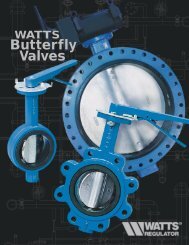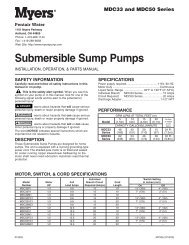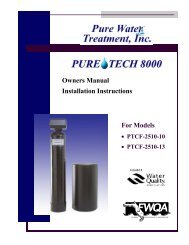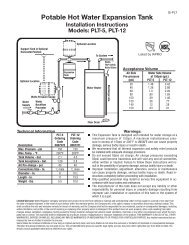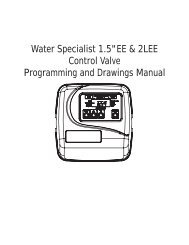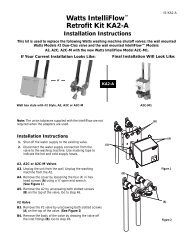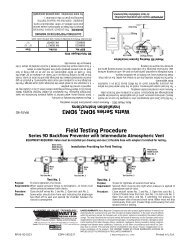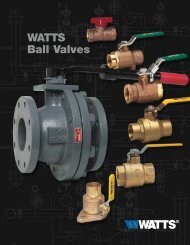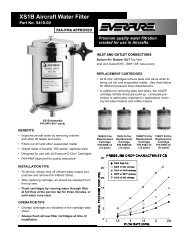Statement of Benjamin H. Grumbles, Assistant ... - Clean My Water
Statement of Benjamin H. Grumbles, Assistant ... - Clean My Water
Statement of Benjamin H. Grumbles, Assistant ... - Clean My Water
Create successful ePaper yourself
Turn your PDF publications into a flip-book with our unique Google optimized e-Paper software.
STATEMENT OFBENJAMIN H. GRUMBLESASSISTANT ADMINISTRATOR FOR WATERU.S. ENVIRONMENTAL PROTECTION AGENCYBEFORE THESUBCOMMITTEE ON WATER RESOURCES AND ENVIRONMENTCOMMITTEE ON TRANSPORTATION AND INFRASTRUCTUREU.S. HOUSE OF REPRESENTATIVESFebruary 16, 2005Mr. Chairman and Members <strong>of</strong> the Subcommittee, I am Ben <strong>Grumbles</strong>, <strong>Assistant</strong> Administrator for<strong>Water</strong> at the United States Environmental Protection Agency (EPA). I appreciate the opportunity todiscuss the President’s fiscal year (FY) 2006 budget request for EPA’s National <strong>Water</strong> Program. Therequest is over $2.8 billion, or 38% <strong>of</strong> the Agency’s overall request, and will advance our efforts, and those<strong>of</strong> our State, Tribal, and local partners, to ensure America’s water is clean, safe, and secure.OVERVIEWAs a country, we have made remarkable progress over the years in protecting and restoring ourwaters and wetlands. We have much left to do. EPA is committed to meeting the challenge and toaccelerating the pace. EPA continues to find that collaboration is the lynchpin to success in moving ourprograms forward. Collaboration allows us to benefit from everyone’s ideas, efforts, and even resources.And, by engaging all partners, we create momentum as we reach for the next level <strong>of</strong> environmentalprotection.EPA is committed to sustaining our core programs in order to continue achieving environmentalprogress. This budget, Mr. Chairman, will help us continue and accelerate progress toward the publichealth and environmental goals set forth in EPA’s Strategic Plan. With the help <strong>of</strong> States, Tribes, and otherpartners, we are confident <strong>of</strong> significant progress in the years ahead. Our success will depend on exploringand embracing better ways to ensure effective, efficient, and equitable results. Specifically, the budget weare presenting today will help us:< continue to make progress in restoring the Nation’s polluted waters,< increase the waters open for shellfishing,
estore polluted waters for swimming,< continue to improve the health <strong>of</strong> the country’s major coastal ecosystems,< achieve a net increase <strong>of</strong> wetlands, and,< increase the compliance with drinking water standards.Accomplishing these ambitious goals will require everyone involved in water programs to focus oneffectively implementing the core programs <strong>of</strong> the <strong>Clean</strong> <strong>Water</strong> Act and Safe Drinking <strong>Water</strong> Act. At thesame time, we will work with our partners to strengthen the commitment to collaboration and to develop arange <strong>of</strong> cost-saving innovations, such as watershed permitting and water quality trading.PRIORITIES FOR 2006I want to bring to your attention four key areas <strong>of</strong> the budget that I believe merit special recognition:< improving monitoring <strong>of</strong> surface water and drinking water;< strengthening the nation’s water infrastructure, including water efficiency and system security;< restoring watersheds; and,< protecting our coastal waters, including the Nation’s inland coast, the Great Lakes.MonitoringAs in 2005, monitoring remains one <strong>of</strong> our top priorities. In FY 2006, the President’s budgetrequests an increase <strong>of</strong> $10 million in Section 106 grants to States, for a total <strong>of</strong> $232 million. Within thistotal is $24 million, a $7 million increase, for State water quality monitoring activities. These funds will beused to continue the monitoring network that we established to obtain a statistically valid baseline <strong>of</strong> waterquality conditions at the national level for all water types. It builds upon the 2004 National CoastalCondition Report and the wadeable streams study we will complete at the end <strong>of</strong> 2005. In 2006, the focuswill be on lakes. We intend to repeat these surveys periodically so that we can track trends and givedecision makers and the public the information they need to make informed decisions about their own waterresources and to assess our investments in water quality protection.2
Effective monitoring is essential under both the <strong>Clean</strong> <strong>Water</strong> Act and the Safe Drinking <strong>Water</strong> Actto support effective environmental protection in the information age. Continued success <strong>of</strong> the <strong>Clean</strong> <strong>Water</strong>Act depends on having quality data for:< appropriate water quality standards for each water body;< effective discharge permit limits for regulated entities; and< total maximum daily load (TMDL) plans for impaired waters and other approaches that address bothpoint and non-point sources <strong>of</strong> pollution.These standards, limits, and plans rely on our ability to monitor water quality, whether at the point <strong>of</strong>discharge or in the receiving waters. Monitoring under the <strong>Clean</strong> <strong>Water</strong> Act is also critical to understandingwhere and when our partners can use <strong>Clean</strong> <strong>Water</strong> Act tools to help safeguard drinking water throughsource water protection programs.<strong>Water</strong> InfrastructureThis Committee knows the value <strong>of</strong> water infrastructure and the size <strong>of</strong> the challenge – and so doesEPA. To support sustainable wastewater infrastructure, EPA will continue to provide annual capitalizationgrants to the <strong>Clean</strong> <strong>Water</strong> State Revolving Funds (CWSRF). The budget provides $730 million for theCWSRF. This investment will allow EPA to meet the Administration’s federal capitalization target <strong>of</strong> $6.8billion for 2004 through 2011 and enable the CWSRF to revolve over time at a level <strong>of</strong> $3.4 billion a year.This continued federal investment, with other traditional sources <strong>of</strong> financing, will result insignificant progress in addressing the Nation’s wastewater treatment needs. It will also significantlycontribute to the long-term environmental goal <strong>of</strong> increasing the number <strong>of</strong> watersheds attaining designatedwater quality uses. The President’s budget also maintains the federal commitment to the Drinking <strong>Water</strong>SRF, providing $850 million, and seeks a one-year extension <strong>of</strong> the authority for States to transfer fundsbetween the two SRFs to maximize flexibility in meeting State and local needs.Mr. Chairman, a cornerstone <strong>of</strong> our water budget is its focus on the “four pillars” <strong>of</strong> sustainableinfrastructure. We must provide the tools that help water managers achieve sustainable infrastructure. The3
four pillars that are essential for sustainable infrastructure are: better management, full-cost pricing, waterconservation, and restoration through the watershed approach.Better ManagementOne pillar in our ability to ensure sustainable water infrastructure is better management at the localor facility level. By better management, I mean assuring that facility managers have the suite <strong>of</strong> tools theyneed. These tools include: asset management, environmental management systems, capacitydevelopment, and other systems that successful enterprises have demonstrated to be effective.Full Cost PricingAnother pillar is "full-cost pricing." Pricing that seeks to recover all <strong>of</strong> the costs <strong>of</strong> building,operating, and maintaining a system is absolutely essential to achieving sustainability. Of course, full-costpricing depends upon complete and accurate metering <strong>of</strong> water use in order to charge users fairly for whatthey actually consume. Conservation rates and seasonal rates can further help reduce peak water demand.And, valid concerns about equity can be addressed through "lifeline rates" for the poor. Clearly, we need todevelop and share more information that documents progress in full-cost and conservation pricingapproaches. We took one step toward better information-sharing a few months ago by establishing a newwebsite with pricing information.<strong>Water</strong> ConservationAnother pillar in ensuring sustainable water infrastructure is to encourage efficient use <strong>of</strong> water.Although EPA's focus is water quality, not water quantity, we increasingly find that water quantity andquality issues are inextricably linked. Examples include infrastructure for both water supply and waterquality, and reuse <strong>of</strong> water.EPA will continue to increase its focus on voluntary water conservation and efficiency througheducation, funding, and technical assistance. I am excited to tell you about our efforts to develop a4
voluntary program to identify and promote water efficient products. Among the approaches we areconsidering are voluntary standards, market-based approaches that inform consumers about the benefits <strong>of</strong>water-efficient products, and collaborative efforts with industrial sectors that promote the manufacture andsale <strong>of</strong> these products.Restoration through the <strong>Water</strong>shed ApproachThe final pillar in assuring sustainable water infrastructure is an important water program priority initself. EPA is committed to working on a watershed basis with our State, Tribal, and other partners toprotect human health and restore water quality nationwide. About a decade ago, EPA embraced thewatershed approach, focusing on multi-stakeholder and multi-program efforts within hydrologically-definedboundaries, as a better way to address water quality problems. Today, we are increasingly managing waterquality on a watershed basis.Restoring Our <strong>Water</strong>shedsThe President's budget contains a request for $15 million to continue investing in our Targeted<strong>Water</strong>shed Grants program. This initiative started in 2003, with 20 grants ranging from $300 thousand to $1million. The slight reduction from the FY 2005 enacted amount reflects the absence in this budget <strong>of</strong> thefunding that was provided last year for the Chesapeake Bay Pilot. The Targeted <strong>Water</strong>shed Grants programprovides opportunities to demonstrate the effectiveness <strong>of</strong> market-based approaches, particularly waterquality trading, and collaborations that <strong>of</strong>ten transcend political boundaries to achieve sustainableenvironmental solutions.Many resources under the <strong>Clean</strong> <strong>Water</strong> Act directly support efforts to restore and improve thequality <strong>of</strong> rivers, lakes, and streams. Over the next several years, EPA will rely on this funding to work withStates to assure the continued effective implementation <strong>of</strong> core clean water programs, to restore specificimpaired waterbodies, and to accelerate watershed protection efforts.5
In 2000, States listed some 21,632 waterbodies that are not attaining water quality standardsrequired under section 303(d) <strong>of</strong> the <strong>Clean</strong> <strong>Water</strong> Act. Succeeding in restoring impaired waterbodiesrequires that we set interim and long-tem goals to guide this work. By applying the full range <strong>of</strong> <strong>Clean</strong><strong>Water</strong> Act programs to this problem, EPA and States are working to restore these waterbodies throughwatershed-based planning, market-based approaches and other available tools.In FY 2006, EPA will work with our State and Tribal partners to focus on watershed protection byimplementing Permitting for Environmental Results (PER). This is the most comprehensive, data-richreview <strong>of</strong> State <strong>Clean</strong> <strong>Water</strong> programs in the history <strong>of</strong> the National Pollutant Discharge Elimination System(NPDES). The PER initiative is a multi-year EPA-State partnership aimed at improving the environmentalperformance, efficiency, and the fundamental integrity <strong>of</strong> NPDES programs. The Agency is developing amanagement system that fosters ongoing assessment <strong>of</strong> program integrity, shares and builds on bestpractices for managing environmental results and efficiency, and anticipates opportunities to enhance theprogram.In addressing the backlog <strong>of</strong> expired permits, EPA and States are developing lists <strong>of</strong> “prioritypermits” that allow us to focus on expired permits that have the biggest environmental impact. We arestreamlining the permitting process with electronic permit development tools and technical guidance onwatershed-based permitting. We are also evaluating the fundamental integrity <strong>of</strong> State NPDES programsand working with our State partners to develop program pr<strong>of</strong>iles that we are posting on EPA’s website(www.epa.gov/npdes/per). The pr<strong>of</strong>iles highlight program innovations and areas where programimprovements can be achieved. They establish a baseline for measuring the health <strong>of</strong> the program over thelong term.Besides watershed-based permits, States and EPA can use TMDLs and nonpoint and sourcewater assessments to support restoration efforts. By the end <strong>of</strong> FY 2006, we expect that all EPA-approvedState source water assessment programs will have completed baseline assessments for public watersystems nationwide. With the support <strong>of</strong> many federal programs, States will work with community watersystems on voluntary measures to prevent, reduce, or eliminate threats <strong>of</strong> contamination to source water6
United States and one-quarter <strong>of</strong> the population <strong>of</strong> Canada. Some <strong>of</strong> the world’s largest concentrations <strong>of</strong>industrial capacity are located in the Great Lakes region. In spite <strong>of</strong> their large size, the Great Lakes aresensitive to the effects <strong>of</strong> a wide range <strong>of</strong> pollutants. Responding to the President’s May 2004 ExecutiveOrder, EPA will build on the work already done by former Administrator Mike Leavitt and the Great LakesTask Force to lead and coordinate local, State, Tribal, and federal partners in focusing on environmentalprotection that meets international commitments and provides measurable results. Concurrently, we willcontinue working with partners to restore the chemical, physical, and biological integrity <strong>of</strong> the Great Lakesecosystem by implementing <strong>Clean</strong> <strong>Water</strong> Act core water protection programs and other actions thatsupport the existing 2002 Great Lakes Strategy. The Strategy’s shared, long-range vision (healthy naturalenvironment for wildlife and people, all beaches open for swimming, all fish safe to eat, and Lakes that are asafe source <strong>of</strong> drinking water) is supported by quantifiable and measurable objectives.In support <strong>of</strong> the Great Lakes Legacy Act <strong>of</strong> 2002, the FY 2006 President budget’s requestincludes $50 million, representing a $5 million increase over the FY 2005 President's budget and $27.5million over the FY 2005 enacted level, to fund sediment remediation activities at the fully authorized level.In FY 2006, the third year <strong>of</strong> the program, EPA will support up to six projects for remediation which willclean up over a quarter million cubic yards <strong>of</strong> contaminated sediments.WetlandsOur FY 2006 request reflects our continuing commitment to the goal <strong>of</strong> increasing the quantity andquality <strong>of</strong> the Nation’s wetlands. On Earth Day 2004, the President announced his commitment to restore,improve, and protect three million acres <strong>of</strong> wetlands by 2009.Achieving the Administration's commitment requires stronger State, Tribal, and local programs toprotect the most vulnerable wetlands. To support their efforts, the President’s Budget contains a request for$20 million for grants to help States and Tribes develop, enhance, implement, and administer wetlandprograms. This is a 25% increase over the level Congress appropriated for FY 2005 and will help theAdministration surpass "no net loss" and move toward its new "net gain" goals.8
Homeland SecurityThe Nation’s drinking water systems have taken the first critical steps toward enhancing security –identifying their vulnerabilities and developing emergency response plans. As these systems begin tomitigate their weaknesses, they need additional guidance to help them adopt effective security programsthat will detect intentional acts <strong>of</strong> contamination. In response to these needs and consistent withHomeland Security Presidential Directives 7 and 9, EPA will deploy, in selected cities, with key federal andwater sector partners, a pilot monitoring and surveillance program for early warning <strong>of</strong> intentionalcontamination events. To complement this detection program, EPA will provide additional tools, training,and exercises that the largest drinking water utilities need to prevent, respond to, and recover from aterrorist or other intentional attack. EPA’s FY 2006 request includes an additional $44 million to carry outthese responsibilities.CONCLUSIONThere are always new challenges facing the Nation’s water programs. Effective collaboration withour many partners – the Congress, States, Tribes, and public and private groups and individuals – willcontinue to give us many opportunities for ensuring clean and safe water. I look forward to working with thisCommittee to accomplish these important national goals.This concludes my prepared remarks; I would be happy to respond to any questions you may haveat this time.* * *9



